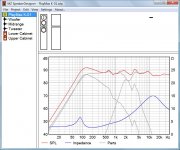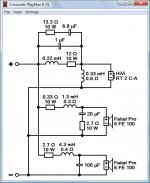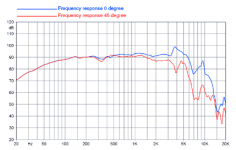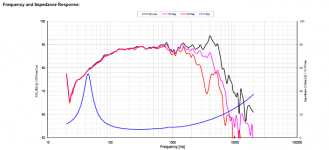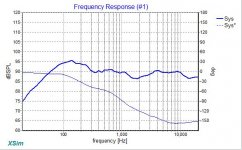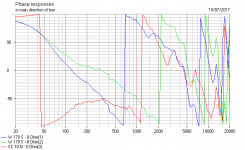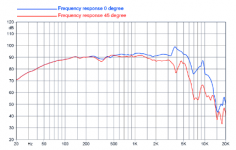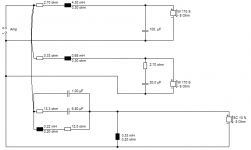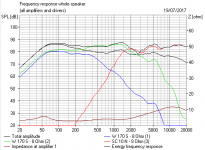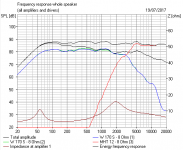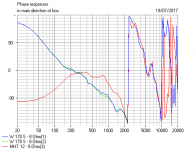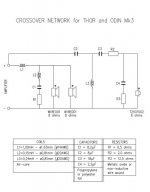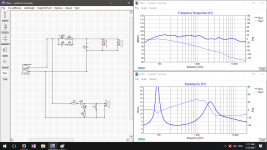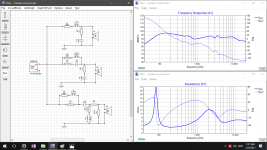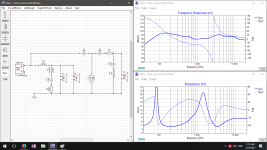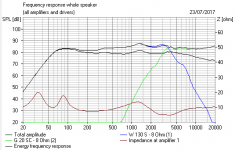This design proposal looks strange when you calculate that two of the faitals with baffle step loss accounted for, gives spl just about close to hivi tweeter so there seems no particular reason to perform woofer attenuation for that matter.
This design proposal looks strange when you calculate that two of the faitals with baffle step loss accounted for, gives spl just about close to hivi tweeter so there seems no particular reason to perform woofer attenuation for that matter.
I agree but a dip in frequency is not something that we should design for but isnt a flat response more beneficial?
Last edited:
The series resistor in the woofer filter is indeed unusual, and a resistor bypassing the tweeter capacitor is always a bad idea. The reason probably is to prevent the impedance from going too low and to do some response shaping in the bass as well.
I don't get that dip in my simulation of the PlayMax K-01 using the woofer measurements from diBirama: Faital Pro 6FE100
I don't get that dip in my simulation of the PlayMax K-01 using the woofer measurements from diBirama: Faital Pro 6FE100
Attachments
Last edited:
I looked at the FaitalPro 6FE100 and thought I've seen that sort of thing before. It's very similar to the Peerless Nomex 164 aka 830875.
PEERLESS-NOMEX-164
A little more efficient at 90dB, and more of a 0.5 cu feet closed box driver IMO. You usually notch speakers like this at about 4.5kHz= 6uF/0.2mH/2.2R shunt or a RC tank across the bass coil, which is what Troels does to the mid in a 2.5 way.
I think we decided the Troels Nomex 164 could be improved, as it goes. I think you are better off using a MTM style filter. Even if it's laid out TMM.
PEERLESS-NOMEX-164
A little more efficient at 90dB, and more of a 0.5 cu feet closed box driver IMO. You usually notch speakers like this at about 4.5kHz= 6uF/0.2mH/2.2R shunt or a RC tank across the bass coil, which is what Troels does to the mid in a 2.5 way.
I think we decided the Troels Nomex 164 could be improved, as it goes. I think you are better off using a MTM style filter. Even if it's laid out TMM.
Attachments
Really ? the best speakers I've had for 5 years now !I think we decided the Troels Nomex 164 could be improved,
I've just increase R1051 to 1.2 ohms and lowered the box tuning to 40 hz from the original design by TG.
They are sounding VERY good IMHO 🙂
Construction d'enceintes "Nomex 164" - Le blog de pguerin
Thank you for the explanation, I have been told that mtm designs suffer from phasing issues and tmm is a bit better. I am considering a tmm arrangement with the .5 way woofer in a mltl enclosure and the tweeter and top woofer in a 0.7 sealed enclosure. I am hoping that this will give better transient response overall.
I looked at the FaitalPro 6FE100 and thought I've seen that sort of thing before. It's very similar to the Peerless Nomex 164 aka 830875.
PEERLESS-NOMEX-164
A little more efficient at 90dB, and more of a 0.5 cu feet closed box driver IMO. You usually notch speakers like this at about 4.5kHz= 6uF/0.2mH/2.2R shunt or a RC tank across the bass coil, which is what Troels does to the mid in a 2.5 way.
I think we decided the Troels Nomex 164 could be improved, as it goes. I think you are better off using a MTM style filter. Even if it's laid out TMM.
I'm not surprised about inverting the tweeter polarity. I just simmed your filter. The phase for your tweeter circuit is all over the place! I see no merit in that circuit whatsoever. It's a complete muddle IMO. Troels' circuit looks much nearer where you want to be.
You can use an MTM circuit design even with a TMM. It's simpler IMO. But do what you like. Joe D'Appolito's original MTM design was a 90 degree phase 3rd order butterworth. But you can do butterworth with an MT and MMT as well. It gives a more even power response around the room and off-axis.
Between LR2 and LR4 lies BW3! It's a valid solution, and in essence it just pushes the drivers a bit harder at crossover to fill the inevitable -3dB power hole above and below axis of even order filters. So it sounds more natural in the room. Some drivers play nicely, others don't.
You can use an MTM circuit design even with a TMM. It's simpler IMO. But do what you like. Joe D'Appolito's original MTM design was a 90 degree phase 3rd order butterworth. But you can do butterworth with an MT and MMT as well. It gives a more even power response around the room and off-axis.
Between LR2 and LR4 lies BW3! It's a valid solution, and in essence it just pushes the drivers a bit harder at crossover to fill the inevitable -3dB power hole above and below axis of even order filters. So it sounds more natural in the room. Some drivers play nicely, others don't.
Last edited:
Thanks for the info and the link to diBirama
The series resistor in the woofer filter is indeed unusual, and a resistor bypassing the tweeter capacitor is always a bad idea. The reason probably is to prevent the impedance from going too low and to do some response shaping in the bass as well.
I don't get that dip in my simulation of the PlayMax K-01 using the woofer measurements from diBirama: Faital Pro 6FE100
Here's the sim with any old 6" woofers and 1" tweeter on positive polarity. It's a dreadful tweeter circuit. No real rolloff, and terrible phase. Whatever were you thinking of! 😱
I appreciate the planar tweeter is something else: HiVi RT2C-A Planar Isodynamic Tweeter
But basic principles still apply. I think you must lose the 0.22mH and 12R. The 1uF is evidently just a bit of top end lift.
I appreciate the planar tweeter is something else: HiVi RT2C-A Planar Isodynamic Tweeter
But basic principles still apply. I think you must lose the 0.22mH and 12R. The 1uF is evidently just a bit of top end lift.
Attachments
Last edited:
What I would try with this Naresh, is a simple circuit. Below.
The only real variables are the notch point, here 6kHz on the Visaton W170S. Which can be taken down to 4.5 or 5kHz with, say, a 1.2uF or 1.5uF cap instead of the 1uF.
And adjust tweeter level. It all works nicely as a near LR2. It's really not far away from Joe D'Appolito's SEAS Thor design, albeit with tidier woofers. THOR
I've built stuff like this, and it's OK. It'll work as a TMM too. You'll want the tweeters at ear height.
The only real variables are the notch point, here 6kHz on the Visaton W170S. Which can be taken down to 4.5 or 5kHz with, say, a 1.2uF or 1.5uF cap instead of the 1uF.
And adjust tweeter level. It all works nicely as a near LR2. It's really not far away from Joe D'Appolito's SEAS Thor design, albeit with tidier woofers. THOR
I've built stuff like this, and it's OK. It'll work as a TMM too. You'll want the tweeters at ear height.
Attachments
What I would try with this Naresh, is a simple circuit. Below.
The only real variables are the notch point, here 6kHz on the Visaton W170S. Which can be taken down to 4.5 or 5kHz with, say, a 1.2uF or 1.5uF cap instead of the 1uF.
And adjust tweeter level. It all works nicely as a near LR2. It's really not far away from Joe D'Appolito's SEAS Thor design, albeit with tidier woofers. THOR
I've built stuff like this, and it's OK. It'll work as a TMM too. You'll want the tweeters at ear height.
Ok I will try it.
On another note what are your views on a tmm physical arrangement in a bipole transmission line configuration? I am thinking this will negate the need for baffle step compensation and will reduce movement of the enclosure, all of which will translate into better sound.
Also am I correct in stating that a tmm dipole speaker configuration will result in a better polar response with a loss of low frequency?
Crossover design
I have some screenshots of the different model of crossovers.
Which one will you all recommend to go with?
the system 7 crossover looks the best for frequency response

impedance looks well controlled in the playmax cross except for at high frequencies
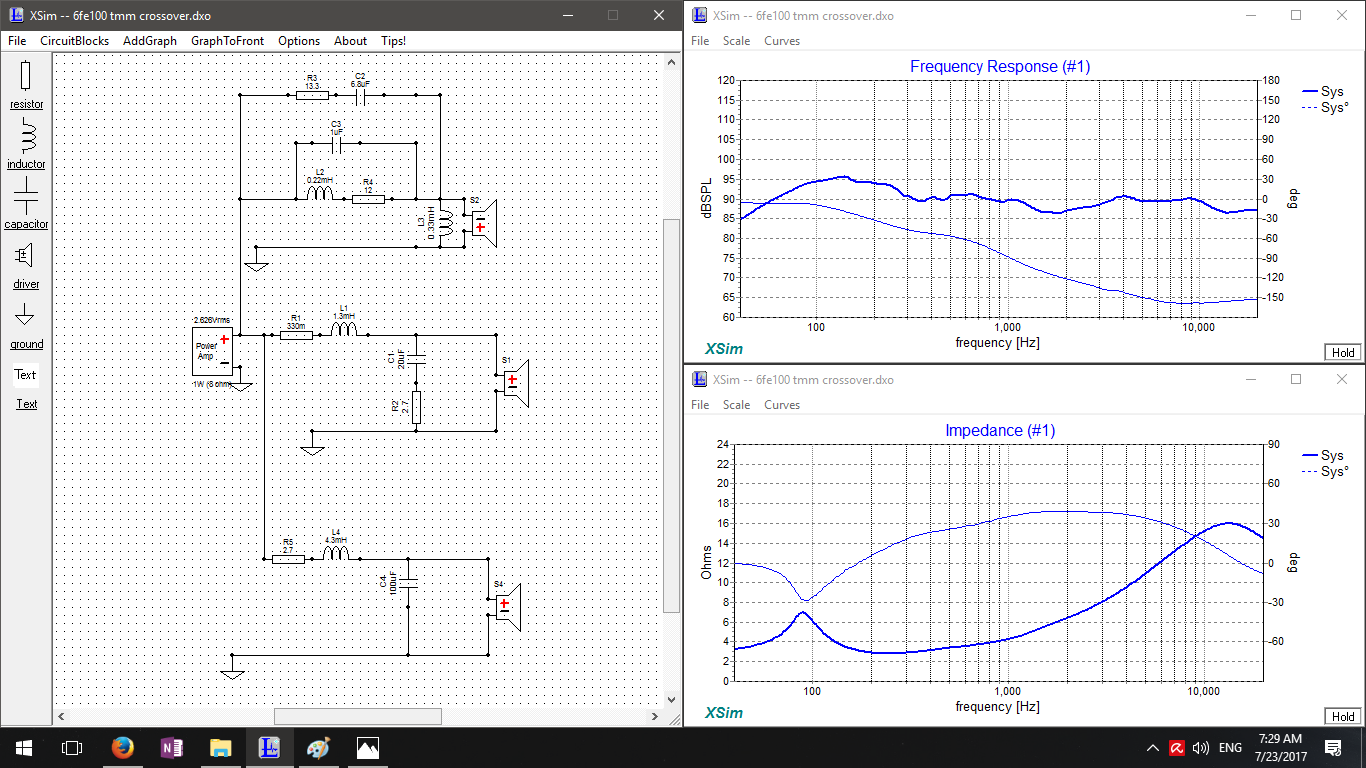
troeble cross
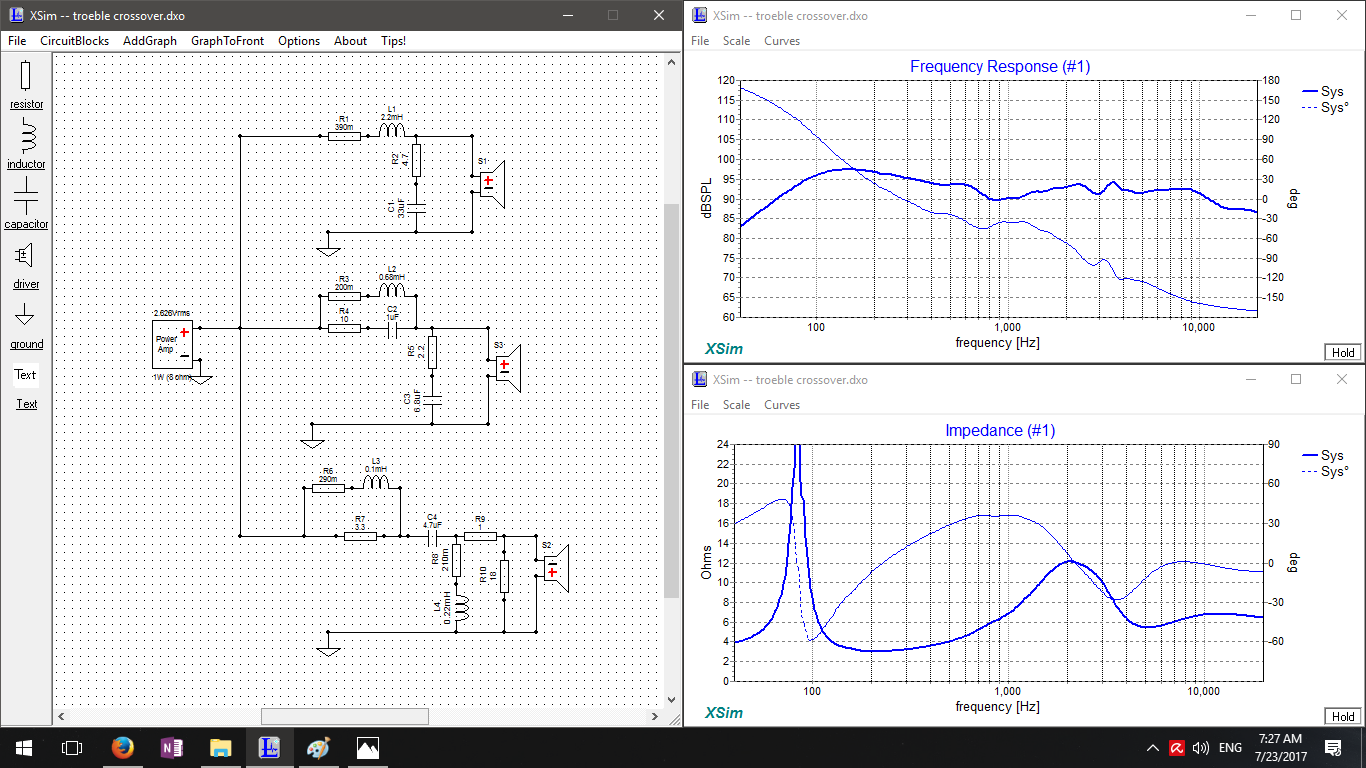
THOR crossover, I have found when polarity on the tweeter is reversed there is no dip in frequency response, what does this mean?
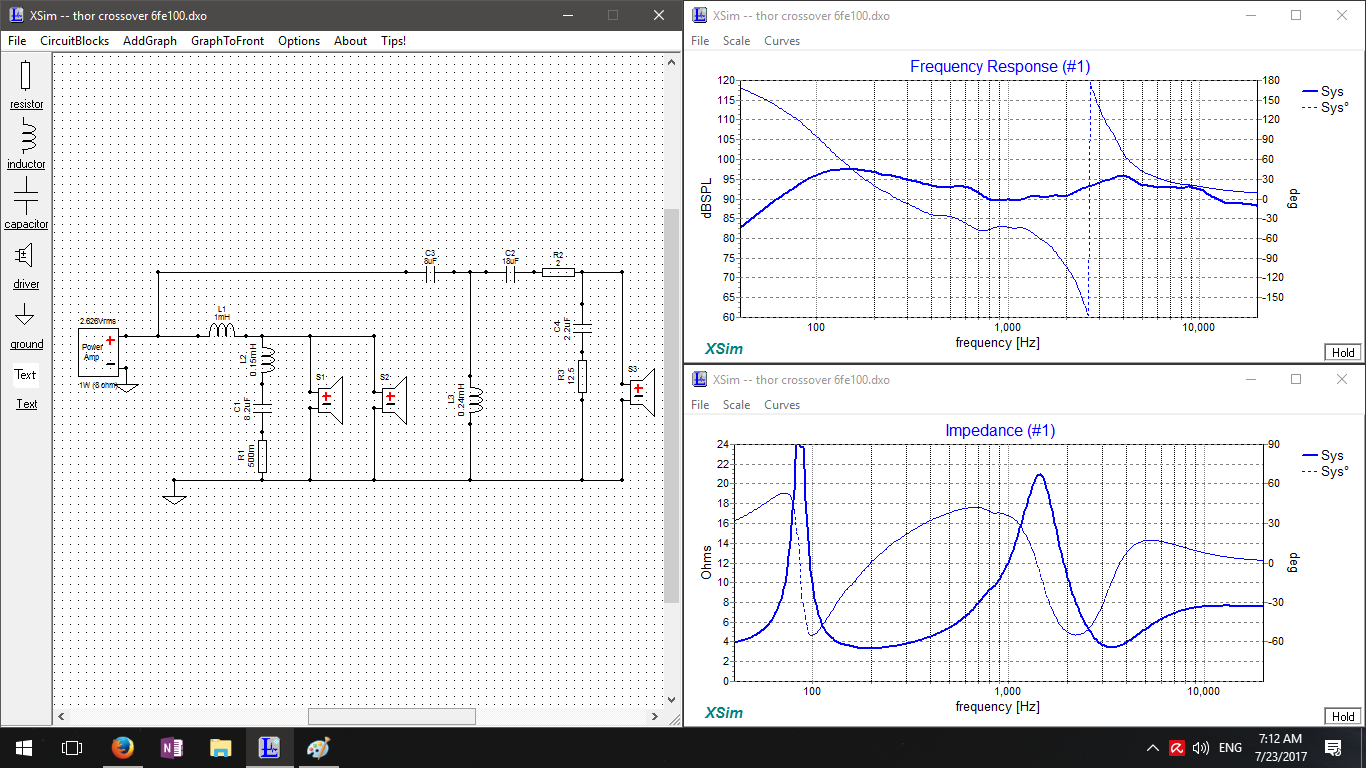
I have some screenshots of the different model of crossovers.
Which one will you all recommend to go with?
the system 7 crossover looks the best for frequency response
impedance looks well controlled in the playmax cross except for at high frequencies
troeble cross
THOR crossover, I have found when polarity on the tweeter is reversed there is no dip in frequency response, what does this mean?
Attachments
Last edited:
There's at least a dozen ways to design a crossover that does similar things.
You usually end up around 2.5kHz on a 6" bass. A TMM 2.5 way has very deep bass, maybe too much because you end up with 6dB of bafflestep.
MTM filters can be easier.
Tony Gee's Proteus tries two different filters:
Humble Homemade Hifi - Archive
It's interesting that you make the SEAS Thor MTM to be a BW3, because that is the filter that can use either polarity, being 90 degree phase. In fact Joe D'Appolito advocated BW3 for an MTM to get the lobe horizontal.
Here's another BW3. You can see the 90 degree phase.
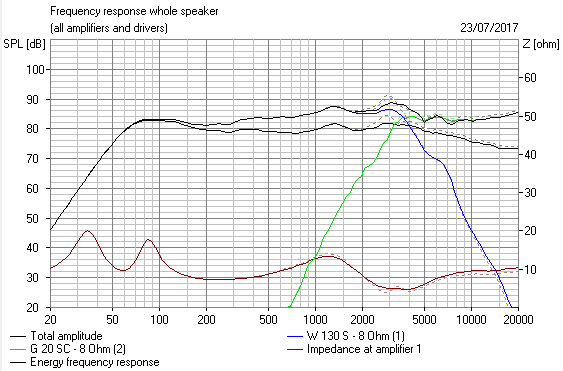
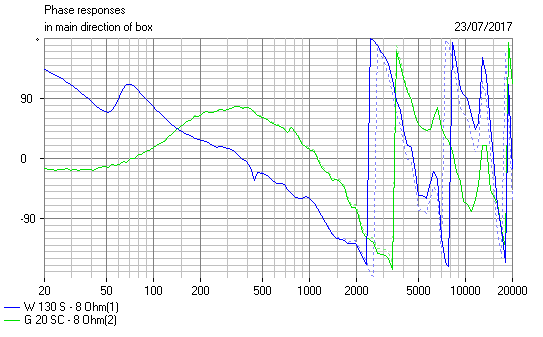
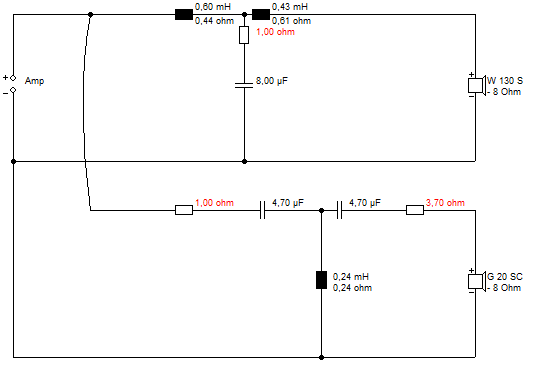
If we are lucky, flipping polarity on the tweeter should preserve the frequency response. Not create the deep null of a LR2 or LR4. Below. 😎
You usually end up around 2.5kHz on a 6" bass. A TMM 2.5 way has very deep bass, maybe too much because you end up with 6dB of bafflestep.
MTM filters can be easier.
Tony Gee's Proteus tries two different filters:
Humble Homemade Hifi - Archive
It's interesting that you make the SEAS Thor MTM to be a BW3, because that is the filter that can use either polarity, being 90 degree phase. In fact Joe D'Appolito advocated BW3 for an MTM to get the lobe horizontal.
Here's another BW3. You can see the 90 degree phase.
If we are lucky, flipping polarity on the tweeter should preserve the frequency response. Not create the deep null of a LR2 or LR4. Below. 😎
Attachments
Im going to build a simple 2way with the 6FE100 in tlines before I attempt the MTM/TMM build. I believe I need to get my feet wet before attempting more challenging builds.
I have narrowed my choices of tweeter on ability to play low and off axis response to 15khz. My choices are:-
Dayton RS28F $63.00
SB Acoustics SB26STAC-C000-4 $55.20
SB Acoustics SB29RDC-C000-4 $57.40
I am leaning towards SB Acoustics SB26STAC-C000-4. Has anyone tried all these tweeters and which one will you recommend?
I have narrowed my choices of tweeter on ability to play low and off axis response to 15khz. My choices are:-
Dayton RS28F $63.00
SB Acoustics SB26STAC-C000-4 $55.20
SB Acoustics SB29RDC-C000-4 $57.40
I am leaning towards SB Acoustics SB26STAC-C000-4. Has anyone tried all these tweeters and which one will you recommend?
Last edited:
Göran has some measurements of the two sb acoustics tweeters.
www.audioexcite.com >> SB Acoustics SB26STAC-C000-4
www.audioexcite.com >> SB Acoustics SB29RDC-C000-4
www.audioexcite.com >> SB Acoustics SB26STAC-C000-4
www.audioexcite.com >> SB Acoustics SB29RDC-C000-4
Göran has some measurements of the two sb acoustics tweeters.
www.audioexcite.com >> SB Acoustics SB26STAC-C000-4
www.audioexcite.com >> SB Acoustics SB29RDC-C000-4
Thanks for the data
1. If you guys had to choose between the sb26 stac vs the rs28f for a xo frequency around 1400-1500 which one will you go with?
2. Would it be advisable to use a waveguide with these tweeters ? And would low freq output be increased in a waveguide? I am looking at the EOS6 waveguide. Any other recommendations?
3.From research I have seen that the sb26 has an efficiency of 91 and has great off-axis response and the rs28f has an efficiency of 87 but goes lower. When I checked the frequency response graphs I see both have great response on the low end. Which of the two has less harmonic distortion?
Edit
Found some answers here:
http://www.diyaudio.com/forums/multi-way/292719-tweeter-100-a-2.html#post4741999
Göran has some measurements of the two sb acoustics tweeters.
www.audioexcite.com >> SB Acoustics SB26STAC-C000-4
www.audioexcite.com >> SB Acoustics SB29RDC-C000-4
Thanks for the data
1. If you guys had to choose between the sb26 stac vs the rs28f for a xo frequency around 1400-1500 which one will you go with?
2. Would it be advisable to use a waveguide with these tweeters ? And would low freq output be increased in a waveguide? I am looking at the EOS6 waveguide. Any other recommendations?
3.From research I have seen that the sb26 has an efficiency of 91 and has great off-axis response and the rs28f has an efficiency of 87 but goes lower. When I checked the frequency response graphs I see both have great response on the low end. Which of the two has less harmonic distortion?
I am constructing a TM with the Faital Pro 6FE100 that has an efficiency of 91db.
Edit
Found some answers here:
http://www.diyaudio.com/forums/multi-way/292719-tweeter-100-a-2.html#post4741999
SB Acoustics SB26STAC Tweeter Tests - Techtalk Speaker Building, Audio, Video Discussion Forum
So far the RS28F is the best choice to cross at 1500, however I am tempted to raise the xo freq to 2000 and utilize the SB26STAC ... decisions ... decisions..
Last edited:
Due to the cone break up on the 6FE100 and the resonance of the sb26stac i am considering going to a 3 way that should eliminate these issues. I am now looking for a mids preferably less than 4" to cover 400Hz to 5-6k. Recommendations will be welcomed.
- Home
- Loudspeakers
- Multi-Way
- Looking to build a TMM speaker system
